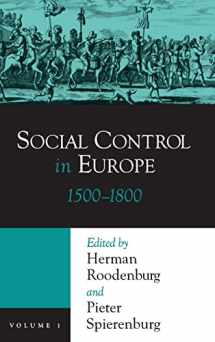
SOCIAL CONTROL IN EUROPE V1: 1500-1800 (HISTORY CRIME & CRIMINAL JUS)
ISBN-13:
9780814209684
ISBN-10:
0814209688
Edition:
1
Author:
Pieter Spierenburg, Herman Roodenburg
Publication date:
2004
Publisher:
Ohio State University Press
Format:
Hardcover
392 pages
FREE US shipping
Book details
ISBN-13:
9780814209684
ISBN-10:
0814209688
Edition:
1
Author:
Pieter Spierenburg, Herman Roodenburg
Publication date:
2004
Publisher:
Ohio State University Press
Format:
Hardcover
392 pages
Summary
SOCIAL CONTROL IN EUROPE V1: 1500-1800 (HISTORY CRIME & CRIMINAL JUS) (ISBN-13: 9780814209684 and ISBN-10: 0814209688), written by authors
Pieter Spierenburg, Herman Roodenburg, was published by Ohio State University Press in 2004.
With an overall rating of 3.7 stars, it's a notable title among other
European History
(Historical Study & Educational Resources, Criminology, Social Sciences) books. You can easily purchase or rent SOCIAL CONTROL IN EUROPE V1: 1500-1800 (HISTORY CRIME & CRIMINAL JUS) (Hardcover) from BooksRun,
along with many other new and used
European History
books
and textbooks.
And, if you're looking to sell your copy, our current buyback offer is $0.3.
Description
This two-volume collection of essays provides a comprehensive examination of the idea of social control in the history of Europe. The uniqueness of these volumes lies in two main areas. First, the contributors compare methods of social control on many levels, from police to shaming, church to guilds. Second, they look at these formal and informal institutions as two-way processes. Unlike many studies of social control in the past, the scholars here examine how individuals and groups that are being controlled necessarily participate in and shape the manner in which they are regulated. Hardly passive victims of discipline and control, these folks instead claimed agency in that process, accepting and resisting--and thus molding the controls under which they functioned. In both volumes, an introduction outlines the origins and the continuing value of the concept of social control. The introductions are followed by two substantive sections. The essays in part one of volume I focus on the interplay of ecclesiastical institutions and the emerging states; those in part two of volume I look more explicitly at discipline from a bottom-up perspective. The essays in part one of volume 2 explore the various means by which communities--generally working-class communities--in nineteenth-and twentieth-century Europe were subjected to forms of discipline in the workplace, by the church, and by philanthropic housing organizations. It notes also how the communities themselves generated their own forms of internal control. Part two of volume 2 focuses on various policing institutions, exploring in particular the question of how liberal and totalitarian regimes differed in their styles of control,repression, and surveillance.


We would LOVE it if you could help us and other readers by reviewing the book
Book review

Congratulations! We have received your book review.
{user}
{createdAt}
by {truncated_author}


